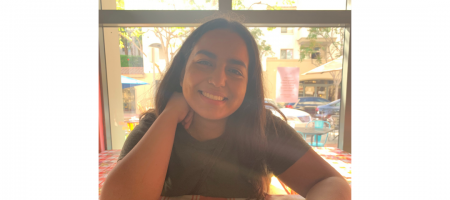Student Spotlight – Janet Zamudio
Meet UCLA undergraduate researcher Janet Zamudio!
Janet Zamudio majors in Public Affairs and Geography and is in our Undergraduate Research Fellows Program (URFP)! The title of her project is “A Tale of Two Movements: Coalition Building Between Environmental Justice and Affordable Housing in Los Angeles.” Her hope is that her research will bridge together what is happening within the two movements and academia. Her best piece of advice is to put yourself out there!
How did you first get interested in your research project?
My inspiration for this project stems from my lived experience growing up in the Southeast Los Angeles (SELA) area. I grew up seeing and feeling the effects of environmental racism firsthand: the targeting of BIPOC communities by the intentional placement of hazardous sites and the official sanctioning of the presence of life-threatening poisons and pollutants, all without these affected communities being represented at the political level. Without even knowing the definition of environmental racism, I lived it day-in and day-out by biking past toxic facilities, breathing polluted air, having to carry an asthma inhaler, and drinking contaminated water. After being exposed to the environmental justice movement and becoming a youth advocate for a local organization, Communities for a Better Environment (CBE), I began to understand the urgency behind the fight against environmental racism and injustice. The COVID-19 pandemic shed a new light on systemic injustices in SELA, magnifying the environmental, healthcare, and housing insecurities that our communities have faced for decades. During this turbulent time, it was impossible not to see how environmental injustices (not having a clean environment) went hand in hand with housing insecurity (the lack of safety and existence in an urban environment). My environmental justice advocacy work, combined with my experience in academia, led me to my current research project, “A Tale of Two Movements: Coalition Building Between Environmental Justice and Affordable Housing in Southeast Los Angeles.”
What has been the most exciting aspect of your research so far?
One of the most exciting aspects of my research so far has been collaborating with other environmental justice advocates and hearing their insight. My faculty mentor, Dr. Juan Herrera, is a well-known researcher in social movements and has extensive knowledge on environmental justice in the urban context. I am excited to contribute to the already existing knowledge on social movements, environmental justice, and affordable housing through an academic perspective while expanding the existing knowledge in SELA on the acts of resistance happening on the ground. So far, having conversed with community organizers has been an honor, a privilege, and insightful for me. I only hope to highlight their work, and the resistance of residents from injustice, in the best way that I can.
What has surprised you about your research or the research process?
As silly as this may sound, I’ve been surprised with how quickly time flies when doing research, especially as an undergraduate student. Aside from the typical responsibilities an undergraduate student has, my research process so far includes creating my research timeline, developing a literature review, and emailing housing and environmental experts in the field. I have been surprised by how each week goes by quickly.
What is one piece of advice you have for other UCLA students thinking about doing research?
Do not be afraid to put yourself out there in research. It is easy to be afraid of Professors and researchers; however, that does not mean you are not allowed to ask for help, question the norms set in research, and/or choose a non-traditional avenue towards research. In an already challenging, selective, and elitist environment, do not be afraid to break down barriers through research.
What effect do you hope your research has in your field, at UCLA, in your community, or in the world?
SELA residents and grassroots organizations have long known the importance of having to choose between a place to live or living nearby environmental toxins. On the other hand, academia has historically lacked the means of highlighting ground up activism. It is my hope that this research will bridge together what is happening within these two movements and academia. What I also hope to achieve is to highlight the real life experiences people have in SELA while exploring the implications these two social movements have on navigating the U.S. legal system.


